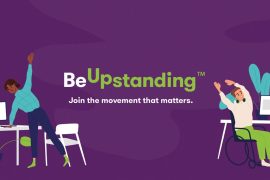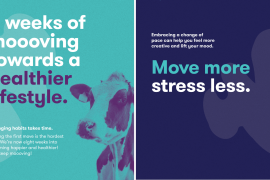BeUpstanding is a big project. I mean really big. Besides the main program of research and the associated NHMRC Implementation Trial, we have a range of students working on projects in the background, helping to expand the evidence base around what works to help people stand up, sit less and move more. I’m Jason, one of the honours students involved in the BeUpstanding program. If you are an avid reader of our blog then you have met me before here. Today we are going dive into my research project which is focused on champion and workplace characteristics, and what these mean for successful implementation of BeUpstanding in your workplace.
One of the key design features of BeUpstanding is the use of a ‘workplace champion’ in delivering the program workplace. Workplace champions are individuals who nominated themselves (or have been nominated by their employer) that have the interest and the capacity to implement BeUpstanding in their workplace. Champions have been shown to be economical, effective at disseminating information and provide an important role model for staff. But who makes a successful champion?
A range of studies have identified some skills and attributes that contribute to being a successful workplace champion. These include having the ability to communicate effectively across the organisation, being passionate about staff health and well-being, being motivated, and having supportive management and peers. Personal traits, such as self-efficacy, perseverance and resilience, as well as the environment in which the champion works, has also been shown to be important. For my honours project, I was interested in examining these factors in champions participating in BeUpstanding.

Characteristics of BeUpstanding Champions and Workplaces
During the registration process champions are asked to complete a ‘champion profile’. We used data from 180 champions who had registered with BeUpstanding between September 2017 and September 2019 to understand a bit more about the amazing people who were signing up to be a workplace champion. Our youngest champion was 20 and the oldest was 68, with an average age of 41 years. Our data showed that the majority of our champions were female (74%) with 40% responding that they were middle management. Two-thirds of champions had some workplace health training and about half had delivered a workplace health program before. This means that half were delivering a program for the first time, which is fantastic to see.
Many of our participating workplaces are from the public sector (61%), with about a third based in rural/regional areas, and 28% from blue-collar workplaces. The BeUpstanding program has attracted work teams from a broad range of industries, the most common being Health Care / Social Assistance (33% of teams). Notably, over three quarters (77%) of champions said that employees had access to sit to stand workstations. This high percentage likely reflects that these organisations are already invested in addressing prolonged workplace sitting. Findings from the workplace audit (n=80 teams) also showed that half of work teams had no budget for wellness activities, only half encouraged stair use, and 79% of teams had no established wellness goals.
Diving in a bit deeper
In addition to the data collected through the Champion profile survey and workplace audit, I also asked champions who had recently signed up to complete an additional survey to understand a bit more about them and their work teams. The characteristics assessed were:
- Self-efficacy – Self-efficacy was looked at to see if people believed they were able to execute a specific course of action. Do champions believe that they have the ability to implement BeUpstanding in their workplace?
- Perseverance – Implementing BeUpstanding, or any workplace change, can be difficult and present many challenges. We wanted to know if champions felt they could ‘push through’ these challenges.
- Resilience – If perseverance is about pushing through challenges, then resilience is about the tools you have as an individual, such as coping mechanisms, learned skills and environmental supports, to protect yourself from the potential negative impacts that these challenges may cause. Do our champions posses enough ‘skills’ to keep going when things get stressful?
- Individual readiness to change – Health behaviour change is hard! Individual readiness to change can be thought of as the precursor to someone either supporting (high readiness to change) or resisting (low readiness to change) these changes.
- Workplace health climate – This one is about assessing workplace culture. Workplace health climate is influenced by the physical environment, organisational characteristics, formal and informal relationships, personalities, members and leadership. It distinguishes one organisation from another, influences behaviour, and is based on the collective perception of the organisation.
During my honours I was able to collect this additional data from fifteen champions. Findings showed that champions rated themselves highly for self-efficacy and resilience and rated themselves less highly for perseverance, when compared to results in the broader literature. This means that champions feel they have the ability to implement BeUpstanding in their workplace (self-efficacy) and have the skills to cope if things get stressful (resilience). Although champions scored themselves less highly on perseverance, when compared to self-efficacy and resilience, their results were still in line with what was reported in the literature. This means that champions felt they could ‘push through’ any potential challenges. These are all encouraging signs of potential champion success.
Individual readiness to change and workplace health climate, are important things to understand in a workplace health promotion context, but the way they were measured in this study meant that the results that they produced weren’t especially helpful in telling us what we wanted to know. We surveyed only one person (the champion), which gives a very narrow view of these measures. A more appropriate way of measuring individual readiness to change and workplace health climate would be to survey the entire team taking part in BeUpstanding. This method would give us a better understanding of the workplace culture and how members of the work team are supporting or resisting change. Perhaps the next student project?
Where to from here?
All of the characteristics discussed play an important role in the success of champions and by extension BeUpstanding. It is worth bearing in mind that this is only a small study, so it doesn’t pack the statistical firepower to make any specific judgements, and we lack any outcome data so it makes it hard to draw any conclusions about how these characteristics impact the success of the program. Understanding these characteristics may help participating workplaces choose the most appropriate or effective champion to ensure that BeUpstanding creates lasting change in their workplace, or allow us to identify those champions that require extra support. In short we need more data.
Finally we just wanted to say thank-you to all the champions that have taken part in not only this research project, but the broader BeUpstanding research as well. Your contributions are invaluable to what we as researchers do, so thank you! We are still collecting data to further unpack the questions we have identified here, so if you are a BeUpstanding champion or thinking of being a champion and want to be involved please get in touch with us at [email protected].
This post was written by Jason Zischke as part of his Bachelor of Health Science Honours project










Comments are closed.